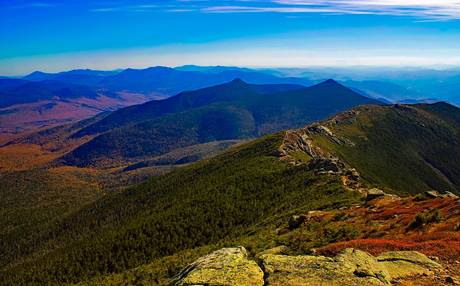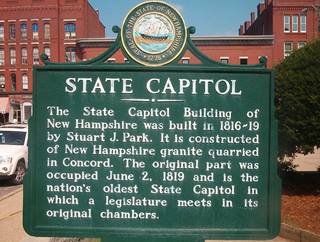New Hampshire Granites, United States

The White Mountains in New Hampshire.
The granite formations of New Hampshire were so historically important to the economy of the state and well known in the region that they gave rise to the state’s nickname ‘The Granite State’. The moniker is attributed to the significant granite number of granite mines in the state and its use in the building of towns, municipal buildings and monuments in the 19th century.
 |
|
| Concord state capitol building built from the state's famous granite deposits: © Karmafist |
As with the Cairngorms, the granites found in New Hampshire are part of a series of pluton bodies of intrusive igneous rock, known as the New Hampshire Plutonic Suite, that were emplaced throughout New England during the Acadian Orogeny: the Bethlehem Granodiorite, Kinsman Granodiorite, Spaulding Tonalite and the Concord Granite. The first three of these members were syn-tectonic, meaning they were concurrent with the Acadian Orogeny; however the Concord Granites (~365Ma), a series of post-tectonic plutons similar to the Cairngorm granites in Scotland, were emplaced 30-50 million years after the Acadian tectonism.
 |
|
| Granites in the river bed at Albany Bridge: © Anthony Quintano |
The Concord Granites are non-foliated (layered) as they were not affected by deformation events in the Acadian Orogeny. They are medium-grained, light grey in colour and composed of plagioclase, microcline, orthoclase, quartz, biotite, and muscovite minerals. The generation of plutons requires the melting of source rocks to create magma. The source rocks for the Corncord Granites are thought to have been greywackes, dark coloured sandstones with poorly sorted angular grains usually formed from submarine avalanches.
Related Links
Other sites
- Twin: Windward Isles
Cwm Idwal
- Twin: Mount Pinatubo
Sperrin Mountains
- Twin: Sierra Nevada
Southern Uplands
- Twin: Nankai
Ben Arnaboll
- Twin: Glarus Thrust
Outer Isles
- Twin: Tohoku Earthquake
Clogherhead and Shannon
- Twin: Papua New Guinea
Cairngorms
- Twin: New Hampshire Granites
Great Glen Fault
- Twin: North Anatolian Fault
The Lizard
- Twin: Troodos Ophiolite
Yoredales
- Twin: Antarctica
Stanage Edge
- Twin: Ganges Delta
Hartland Quay
- Twin: Zagros Range
Amroth-Saundersfoot-Tenby
- Twin: Salt Range, Pakistan
Vale of Eden
- Twin: East African Rift Valley
Zechstein
- Twin: Sicily
Alderley Edge
- Twin: Navajo Sandstone
Isle of Skye
- Twin: Mount Kilimanjaro
Lulworth Cove
- Twin: Albania
Giant's Causeway
- Twin: Cascade du Ray Pic
